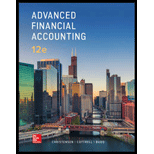
Advanced Financial Accounting
12th Edition
ISBN: 9781259916977
Author: Christensen, Theodore E., COTTRELL, David M., Budd, Cassy
Publisher: Mcgraw-hill Education,
expand_more
expand_more
format_list_bulleted
Textbook Question
Chapter 1, Problem 1.15Q
Within the measurement period following a business combination, the acquisition-date fair valueof buildings acquired is determined to be less than initially recorded. How is the reduction in valuerecognized?
Expert Solution & Answer
Want to see the full answer?
Check out a sample textbook solution
Students have asked these similar questions
Michiko Industries uses flexible budgets. At a normal capacity of 25,000 units, the budgeted manufacturing overhead is $75,000 variable and $300,000 fixed. If Michiko Industries had actual overhead costs of $385,500 for 27,000 units produced, what is the difference between actual and budgeted costs?
Can you solve this general accounting problem with appropriate steps and explanations?
Edison Manufacturing uses a single raw material in its production process. The standard price for a unit of material is $2.25. During the month, the company purchased and used 820 units of this material at a price of $2.10 per unit. The standard quantity required per finished product is 4 units, and during the month, the company produced 200 finished units. How much was the material price variance?
Chapter 1 Solutions
Advanced Financial Accounting
Ch. 1 - What types of circumstances would encourage...Ch. 1 - How would the decision to dispose of a segment of...Ch. 1 - Prob. 1.3QCh. 1 - Prob. 1.4QCh. 1 - Prob. 1.5QCh. 1 - Prob. 1.6QCh. 1 - Prob. 1.7QCh. 1 - Prob. 1.8QCh. 1 - Prob. 1.9QCh. 1 - Prob. 1.10Q
Ch. 1 - Prob. 1.11QCh. 1 - Prob. 1.12QCh. 1 - Prob. 1.13QCh. 1 - Prob. 1.14QCh. 1 - Within the measurement period following a business...Ch. 1 - Prob. 1.16QCh. 1 - Prob. 1.1CCh. 1 - Prob. 1.2CCh. 1 - Prob. 1.3CCh. 1 - Prob. 1.4CCh. 1 - Risks Associated with Acquisitions Not all...Ch. 1 - Prob. 1.6CCh. 1 - Prob. 1.1.1ECh. 1 - Prob. 1.1.2ECh. 1 - Prob. 1.1.3ECh. 1 - Multiple-Choice Questions on Complex Organizations...Ch. 1 - Prob. 1.1.5ECh. 1 - Prob. 1.2.1ECh. 1 - Prob. 1.2.2ECh. 1 - Multiple-Choice Questions on Recording Business...Ch. 1 - Prob. 1.2.4ECh. 1 - Multiple-Choice Questions on Recording Business...Ch. 1 - Multiple-Choice Questions on Reported Balances...Ch. 1 - Multiple-Choice Questions on Reported Balances...Ch. 1 - Prob. 1.3.3ECh. 1 - Prob. 1.3.4ECh. 1 - Prob. 1.4.1ECh. 1 - Prob. 1.4.2ECh. 1 - Prob. 1.4.3ECh. 1 - Multiple-Choice Questions Involving Account...Ch. 1 - Prob. 1.4.5ECh. 1 - Prob. 1.5ECh. 1 - Prob. 1.6ECh. 1 - Prob. 1.7ECh. 1 - Prob. 1.8ECh. 1 - Prob. 1.9ECh. 1 - Prob. 1.10ECh. 1 - Balances Reported Following Combination Palm...Ch. 1 - Goodwill Recognition Spur Corporation reported the...Ch. 1 - Acquisition Using Debentures Planter Corporation...Ch. 1 - Bargain Purchase Using the data resented in E1-13,...Ch. 1 - Prob. 1.15ECh. 1 - Prob. 1.16ECh. 1 - Prob. 1.17ECh. 1 - Prob. 1.18ECh. 1 - Prob. 1.19ECh. 1 - Prob. 1.20ECh. 1 - Prob. 1.21ECh. 1 - Prob. 1.22ECh. 1 - Prob. 1.23ECh. 1 - Prob. 1.24PCh. 1 - Prob. 1.25PCh. 1 - Prob. 1.26PCh. 1 - Acquisition in Multiple Steps Peal Corporation...Ch. 1 - Prob. 1.28PCh. 1 - Prob. 1.29PCh. 1 - Prob. 1.30PCh. 1 - Prob. 1.31PCh. 1 - Computation of Account Balances Saspro Division is...Ch. 1 - Prob. 1.33PCh. 1 - Prob. 1.34PCh. 1 - Prob. 1.35PCh. 1 - Business Combination Following are the balance...Ch. 1 - Prob. 1.37PCh. 1 - Prob. 1.38PCh. 1 - Prob. 1.39PCh. 1 - Prob. 1.40P
Knowledge Booster
Learn more about
Need a deep-dive on the concept behind this application? Look no further. Learn more about this topic, accounting and related others by exploring similar questions and additional content below.Similar questions
- Can you help me solve this general accounting question using the correct accounting procedures?arrow_forwardFeatherSky Ltd. has a balance sheet equity of $7.1 million. At the same time, the income statement shows a net income of $1,120,000. The company has 175,000 shares of stock outstanding. If the benchmark PE ratio is 25, what is the target stock price in one year?arrow_forwardWhat was the sales price per unit?arrow_forward
- Albert Crafts produces two types of handmade candles: Standard and Luxury. The Standard candle sells for $12 with variable costs of $8 per unit, while the Luxury candle sells for $25 with variable costs of $15 per unit. Albert Crafts maintains a sales mix ratio of 70% Standard and 30% Luxury candles. Monthly fixed costs total $42,000. How many total candles (of both types combined) must Albert Crafts sell to break even?arrow_forwardCan you solve this financial accounting problem with appropriate steps and explanations?arrow_forwardParkview Manufacturing produces custom furniture and uses a standard costing system. During April, they purchased 3,200 pounds of raw wood at $4.75 per pound, while the standard price was $4.50 per pound. The standard quantity of wood needed for the 800 chairs produced that month is 3.5 pounds per chair. Calculate both the material price variance and the material quantity variance, and interpret whether each variance is favorable or unfavorable.arrow_forward
- 3 POINTSarrow_forwardBenjiro Manufacturing, which produces metal furniture, is developing direct labor standards. The basic direct labor rate is $28 per hour. Payroll taxes are 21% of the basic direct labor rate, while fringe benefits such as vacation and health care insurance are $11 per hour. What is the standard rate per direct labor hour?arrow_forwardFranklin & Baker Consulting had a net income of $68,000 and net sales of $425,000. Compute the relationship of net income to net sales.arrow_forward
arrow_back_ios
SEE MORE QUESTIONS
arrow_forward_ios
Recommended textbooks for you
 Individual Income TaxesAccountingISBN:9780357109731Author:HoffmanPublisher:CENGAGE LEARNING - CONSIGNMENT
Individual Income TaxesAccountingISBN:9780357109731Author:HoffmanPublisher:CENGAGE LEARNING - CONSIGNMENT



Individual Income Taxes
Accounting
ISBN:9780357109731
Author:Hoffman
Publisher:CENGAGE LEARNING - CONSIGNMENT



What is Fund Accounting?; Author: Aplos;https://www.youtube.com/watch?v=W5D5Dr0j9j4;License: Standard Youtube License